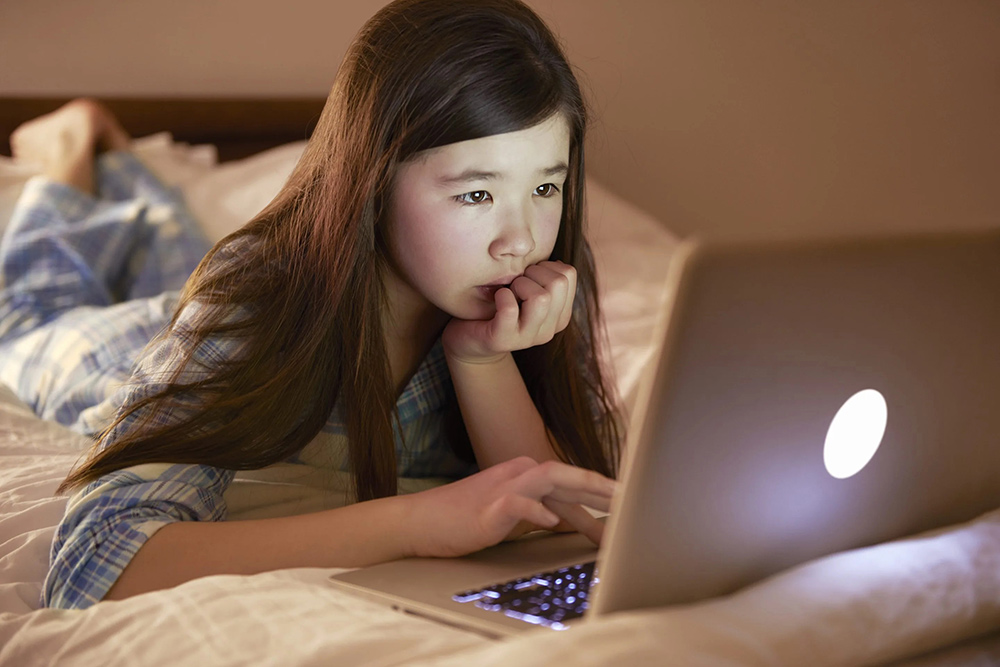
和成年人一样,儿童的屏幕时间多年来一直在上升,在新冠疫情期间更是显著增长。根据美国儿童与青少年精神病学学会(American Academy of Child and Adolescent Psychiatry)的数据,8岁到12岁的孩子每天使用或观看屏幕的时间在4个小时到6个小时之间。这远远超出了儿科医生的专业建议——2岁至5岁的儿童每天的屏幕时间最好不要超过1小时。
蓝光,即高能可见光,是太阳产生的,但我们日常使用的屏幕也是蓝光的一大来源。这让专家们担心,电子设备带来的蓝光正在影响我们的健康。哈佛医学院(Harvard Medical School)早前撰文称,暴露在蓝光下与昼夜节律和睡眠周期的紊乱存在关联。
今年9月16日提交给第60届欧洲儿科内分泌学会年会(60th Annual European Society for Paediatric Endocrinology Meeting)的一份新研究报告发现,在一项对老鼠的研究中,暴露在高水平蓝光下的雌性老鼠提前进入青春期。该研究还指出,这种暴露与褪黑激素水平较低、某些生殖激素水平较高,以及卵巢的物理结构变化有关。
在这项研究中,不同组别的老鼠每天分别暴露在正常光量、6小时和12小时的蓝光下。暴露在蓝光下时间最长的老鼠最早进入青春期。暴露在蓝光下的老鼠的褪黑激素水平也有所下降。此外,暴露在蓝光下时间最长的老鼠还出现了细胞受损和卵巢炎症等情况。该研究的作者艾琳·基林索·乌乌尔卢博士告诉《财富》杂志,褪黑激素“是一个抑制青春期到来的因素”;与青春期相比,褪黑激素在青春期前处于最高水平。
“蓝光是最能够抑制褪黑激素水平的光线。”乌乌尔卢说。“暴露在蓝光下,会降低褪黑激素水平,减少这种激素对青春期到来的抑制作用,从而导致老鼠的青春期提前到来。”
据《华盛顿邮报》(Washington Post)报道,医生报告说更多的女孩提前进入青春期,具体原因仍不明朗。在土耳其进行的一项研究发现,在新冠疫情爆发的第一年,由于不明原因而被诊断为青春期提前的女孩人数比前三年增加了一倍多。美国心理学协会(American Psychological Association)指出,青春期提前与较严重的心理健康问题有关,比如抑郁和社交焦虑。
乌乌尔卢表示,尽管老鼠身上的结果不能推广到儿童身上,但老鼠和人体的“荷尔蒙机制”确实是一样的,该机制包括青春期期间和青春期前后的排卵过程。
媒体援引乌乌尔卢的话报道称,这些发现可能导致蓝光被归类为青春期提前的风险因素。
这项研究的核心意义是,学术界需要更彻底地研究接触蓝光对健康的影响,以及它与青春期提前的关系。
“在未来几年,随着移动电子设备在我们生活中的地位逐渐增加,儿童暴露在蓝光下的时间也会随之增加。”乌乌尔卢说,“我们认为,应该防止儿童使用被称为不可避免的蓝光源的移动设备,特别是在晚上,我们应该限制儿童使用电子设备的时间。”(财富中文网)
译者:任文科
和成年人一样,儿童的屏幕时间多年来一直在上升,在新冠疫情期间更是显著增长。根据美国儿童与青少年精神病学学会(American Academy of Child and Adolescent Psychiatry)的数据,8岁到12岁的孩子每天使用或观看屏幕的时间在4个小时到6个小时之间。这远远超出了儿科医生的专业建议——2岁至5岁的儿童每天的屏幕时间最好不要超过1小时。
蓝光,即高能可见光,是太阳产生的,但我们日常使用的屏幕也是蓝光的一大来源。这让专家们担心,电子设备带来的蓝光正在影响我们的健康。哈佛医学院(Harvard Medical School)早前撰文称,暴露在蓝光下与昼夜节律和睡眠周期的紊乱存在关联。
今年9月16日提交给第60届欧洲儿科内分泌学会年会(60th Annual European Society for Paediatric Endocrinology Meeting)的一份新研究报告发现,在一项对老鼠的研究中,暴露在高水平蓝光下的雌性老鼠提前进入青春期。该研究还指出,这种暴露与褪黑激素水平较低、某些生殖激素水平较高,以及卵巢的物理结构变化有关。
在这项研究中,不同组别的老鼠每天分别暴露在正常光量、6小时和12小时的蓝光下。暴露在蓝光下时间最长的老鼠最早进入青春期。暴露在蓝光下的老鼠的褪黑激素水平也有所下降。此外,暴露在蓝光下时间最长的老鼠还出现了细胞受损和卵巢炎症等情况。该研究的作者艾琳·基林索·乌乌尔卢博士告诉《财富》杂志,褪黑激素“是一个抑制青春期到来的因素”;与青春期相比,褪黑激素在青春期前处于最高水平。
“蓝光是最能够抑制褪黑激素水平的光线。”乌乌尔卢说。“暴露在蓝光下,会降低褪黑激素水平,减少这种激素对青春期到来的抑制作用,从而导致老鼠的青春期提前到来。”
据《华盛顿邮报》(Washington Post)报道,医生报告说更多的女孩提前进入青春期,具体原因仍不明朗。在土耳其进行的一项研究发现,在新冠疫情爆发的第一年,由于不明原因而被诊断为青春期提前的女孩人数比前三年增加了一倍多。美国心理学协会(American Psychological Association)指出,青春期提前与较严重的心理健康问题有关,比如抑郁和社交焦虑。
乌乌尔卢表示,尽管老鼠身上的结果不能推广到儿童身上,但老鼠和人体的“荷尔蒙机制”确实是一样的,该机制包括青春期期间和青春期前后的排卵过程。
媒体援引乌乌尔卢的话报道称,这些发现可能导致蓝光被归类为青春期提前的风险因素。
这项研究的核心意义是,学术界需要更彻底地研究接触蓝光对健康的影响,以及它与青春期提前的关系。
“在未来几年,随着移动电子设备在我们生活中的地位逐渐增加,儿童暴露在蓝光下的时间也会随之增加。”乌乌尔卢说,“我们认为,应该防止儿童使用被称为不可避免的蓝光源的移动设备,特别是在晚上,我们应该限制儿童使用电子设备的时间。”(财富中文网)
译者:任文科
Like that of adults, children’s screen time has gone up over the years, and rose significantly during the COVID-19 pandemic. Kids between ages 8 and 12 spend between four and six hours using or watching screens per day, and teens spend up to nine hours, according to the American Academy of Child and Adolescent Psychiatry. This is dramatically more than the one hour of daily screen time pediatricians recommend for children ages 2 through 5.
Blue light, or high-energy visible light, is produced by the sun but also by our screens, which has left experts concerned over how exposure to blue light through devices is affecting our health. Blue light exposure has been previously linked to disruptions in the circadian rhythm and people’s sleep cycles, according to Harvard Medical School.
In a study of rats, higher levels of blue light exposure were associated with an earlier onset of puberty for females, according to new research presented on September 16 at the 60th Annual European Society for Paediatric Endocrinology Meeting. The study also noted the exposure was associated with lower levels of melatonin, higher levels of some reproductive hormones, and changes in the physical makeup of the ovaries.
In the study, different groups of rats were exposed to a normal light amount, six hours of blue light, and 12 hours of blue light per day. The rats exposed to the longest duration of blue light experienced puberty the earliest. The rats exposed to blue light also had reduced levels of melatonin, which is the hormone that affects sleep, and the rats exposed to blue light for the longest had cell damage and inflammation in their ovaries. Melatonin levels are at their highest during prepuberty, compared with during puberty, which “which is an inhibitory factor in the onset of puberty,” Dr. Aylin Kilinç Uğurlu, the study’s author, tells Fortune.
“Blue light is the light that suppresses melatonin levels the most,” Uğurlu says. “Exposure to blue light decreases melatonin levels and causes early onset of puberty [in rats] by decreasing its inhibitory effect at the onset of puberty.”
During the pandemic, physicians reported more girls experiencing early puberty, according to the Washington Post, and the reasons why are still largely unknown. A study carried out in Turkey found that the number of girls diagnosed with early puberty owing to unknown reasons more than doubled in the first year of the pandemic compared with the previous three years. Early onset of puberty has been linked to higher levels of mental health issues, including depression and social anxiety, according to the American Psychological Association.
While the results in rats cannot be generalized for children, Uğurlu says, the “hormonal mechanism,” including the ovulation process in, before, and after puberty, is the same in rats and humans.
The findings may lead to blue light being categorized as a risk factor for early onset of puberty, Uğurlu says, according to the press alert.
The study, at its core, shows that blue light exposure and its association to early onset puberty needs to be examined more thoroughly.
“In the coming years, as the place of mobile electronic devices in our lives will increase gradually, blue light exposure in childhood will also increase,” says Uğurlu. “We think that the use of mobile devices, known as the inevitable blue light source, should be prevented in the childhood age group, especially in the evening hours, and we should limit the usage times.”






